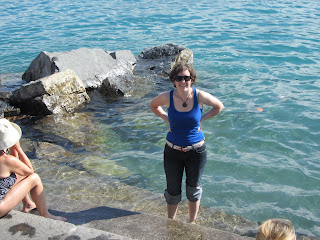 |
| ATLAS (A Toroidal Lhc ApparatuS) |
- 25 meters in diameter and 46 meters long = half the size of Notre Dame in Paris
- weighs 7000 tonnes = the Eiffel tower weighs 7300 tonnes!
- 3000 km of cables
Some interesting facts:
- The data that is outputted in one year from the detector is 3200 terabytes, or 7 km of CD's stacked on top of each other
- The cavern was built from the top down
- They had to first put down 5 meters of concrete to hold the weight of the detector
- The detector was built using an access shaft, similar to a ship in a bottle
- Every year, the detector rises ~0.5 mm because the cavern acts a bit like a bubble in honey! They can adjust for this though.
 |
| The access shaft |
So how does the detector actually work? It's a lot like a gigantic camera, and each layer looks at a particular part of a particle collision. It's starts off with sending two proton beams (or whatever you may have on hand) through the beam line, and colliding them at the detector - sounds simple, but it's more like firing two needles at each other, and expecting them to hit head on. However, the protons come in what are called "bunches", and each "bunch crossing" will have something along the lines of 20 collisions. It's not a lot, but because they can send the protons so fast, they can actually get 40 million crossings per second! This is approximately 1 million collisions per second. Of course, this is too much information for computer systems to handle, so there are triggers that filter the incoming data to only 200 INTERESTING events per second. This means the systems need to be told what is interesting- something like the Higgs boson.
That's how the data arrives, but how can we determine which particles came out of the collisions? This is where all the individual parts come in. I will quickly discuss their purpose, but I won't go into the details, because otherwise this would turn into an essay. If anyone is interested though:
The first section is the Inner Detector (ID). This section lies right next to the beam line and is the first thing to be hit after a collision. This detector records the particles as they pass through the pixels and through this, it is possible to reconstruct a "track". The ID is also surrounded by magnets. This magnetic field will cause a charged particle to curve, meaning that we can then figure out how fast it was going and what its charge was (positive or negative).
The second part is the Calorimeter. There is an electromagnetic and hadronic calorimeter, which focus on mostly electrons/photons and protons/neutrons respectively, even though there is some overlap. The Calorimeters actually "destroy" the particles by having them collide with material, and then the amount of energy that is left behind can tell us the energy and momentum of the incoming particles.
 |
| The endcap muon detector |
 |
| More of the muon detector. The orange-striped pipes are huge toroid magnets. |
The last piece is the Muon Detector (this is what you can see in the picture). Muons are a bit like heavy electrons, and they can pass through most of the detector with almost no problems. That's why the muon detector is the furthest outside. As particles pass through, they ionize the material in the muon detector (strip the electrons), and this can tell us when a muon arrived, and if we have enough pieces being hit by the muon, we can also determine the path it took. This section is also surrounded by magnets, which you can see in the picture too (they have the orange bands).
















